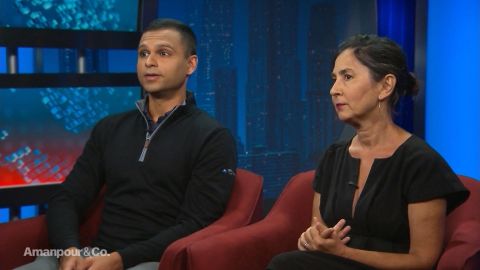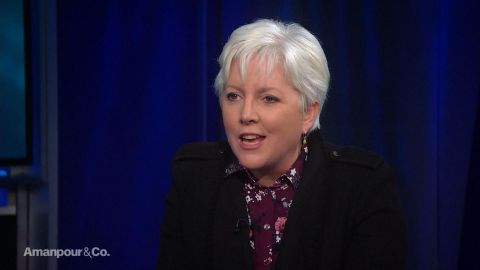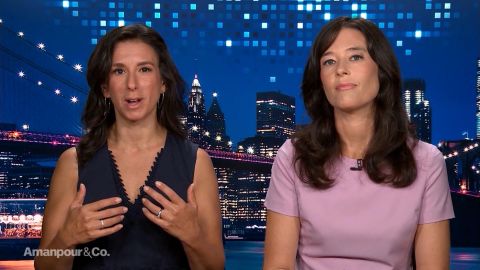Read Transcript EXPAND
CHRISTIANE AMANPOUR: And we’re turning now to a somber anniversary. On September 11, 2001, 18 years ago, the children of the prestigious Stuyvesant High went to school as usual. Little did they know that just a few minutes later, a few blocks away, two planes would fly into the World Trade Center. A coordinated act of terror that would strike the whole world. They were just teenagers and it would take years to process what they experienced. Director Amy Schatz and Stuyvesant graduate Taresh Batra tell their story in her new HBO documentary “In The Shadow of The Towers.” And they both sat down with our Hari Sreenivasan to talk about how that terrible day shaped a generation.
HARI SREENIVASAN, CONTRIBUTOR: Taresh, Amy, thank you so much for joining us. So Taresh, take us back to that day. What do you remember about it?
TARESH BATRA: It was my second or third day of school and I was 13-years- old. So pretty young, pretty excited, pretty bright eyed because it was the first time I was going to school in Manhattan. And I happened to (inaudible) into the classroom as well and, you know, it just happened to have the window to the towers. And so one plane had hit and we were watching the T.V. coverage of that plane and also just looking at the smoke from the window and happened to be going back and forth between the T.V., the towers, the T.V., the towers, and having to be look outside the window and saw the second plane go to the second tower and look back at the T.V. and saw that again in replay. So that kind of spurred, you know, the entire school kind of realizing what was going on.
SREENIVASAN: This was not an accident anymore.
BATRA: Right.
SREENIVASAN: This wasn’t some sort of fluke thing. There might have been intent. Amy, you almost a 360 view. What happened at that moment when they realized that the dynamic changes here? That this is perhaps an intentional act?
AMY SCHATZ: Well, you know, in talking with the eight alumni from Stuyvesant, it seemed you know what struck me is how vivid their recollection was. The memories of the moment and, also, even remembering what they were thinking at that time. The students didn’t all, you know, realize what was happening even though people, you know, had witnessed the planes going into the building. And so, you know, what was stunning is just how visceral, even to this day, 18 years later, the images, the smells, the sounds, there was a lot of uncertainty. There was a lot of, you know, confusion.
SREENIVASAN: Right.
SCHATZ: But nonetheless, it was all very vivid to them.
SREENIVASAN: Right. So for those initial moments, you guys had planned for fire drills but there wasn’t immediate let’s get out of the building, right?
BATRA: That’s right. I think they were trying to figure out whether it was safer for us to stay in the building, contained or evacuate and if we were to evacuate, where would we go? Students were coming from all over the city.
SREENIVASAN: (Inaudible) about Stuyvesant and other parts of the world that are watching that it’s kind of a magnet school. There’s kids that compete to get into this place. And so they’re coming from all over New York City just to get here.
BATRA: Yes. And so I think they weren’t quite sure how to best keep us safe. There were a lot of rumors flying around at the time —
SREENIVASAN: This is an era, pre-Twitter, right?
BATRA: Pre-cell phone.
SCHATZ: Pre-texting.
BATRA: Yes, pre-Internet, kind of at our finger tips. And there were rumors there were additional attacks. There were rumors that there was a gas leak in school. There were rumors that the school itself was going to be attacked and you obviously don’t know what to believe. You don’t know what is going on. Eventually, they did decide to evacuate us.
SREENIVASAN: Where do you go? I mean, the subway is not working anymore. Everything is stopped.
BATRA: right.
SREENIVASAN: What do you do?
BATRA: The only thing I remember is the message being head north. So walk outside and head north. And there’s obviously massive people walking up the west side highway. Just away, you know, it wasn’t that difficult to figure out which way north was.
SREENIVASAN: I mean your school is a few blocks away from the World Trade Center.
BATRA: Right. And so kind of just away from the smoke, away from the soot, and just trying to get as far away as possible.
SREENIVASAN: Here is a clip we have when one of those kids talk about getting a cell phone call for the first time to his parents.
(BEGIN VIDEO CLIP)
UNIDENTIFIED MALE: My father was at work that day. My father is a dentist and he worked in Queens. On the television he saw that this was happening and an assistant, a dental assistant came in the room and told him that Stuyvesant High School exploded. That’s what she heard. She may have heard evacuated and misspoke and my dad collapsed on the ground because he thought that the school exploded. And he was waiting for a call and we had one friend who had a Nextel cell phone which I don’t know if they exist anymore but Nextel at the time, they had the biggest cell phones, the biggest antennas and they just worked everywhere. He was the only friend with a cell phone and he allowed each of us, one after the next, to call home and I called my father and he was bawling crying on the phone. He’s like where are you? I said I’m in Downtown Manhattan. I’m with friends. He says please be safe. They don’t know if there are more attacks happening. And this something I remember to this day, my dad over the phone said to me, please, please, just survive. Him saying that to me made me realize sort of the predicament I was in. I knew but hearing my dad’s concern and his voice that what he said to me, I felt like I — that’s when I realized I was in a war zone. That’s what I felt like.
SREENIVASAN: Amy, we kind of forget and there’s another character in the film that says this but there were kids — these are children that are in the middle of this. And they’re all adults now, but in the coverage of it, that day, most of the time what we’re focusing on is adults walking away from this. This was a financial center. It was a commerce area. People were working there. But here are these group of kids going to school that were witnessing and really part of historical event.
SCHATZ: Right. What was so poignant about it I think is the fact that these were kids that are 13 and not only imagining what they saw, you know, seeing the buildings collapsing, the plane crashing into the buildings, seeing jumpers, seeing this enormous dust cloud coming out at them, but also the idea, like, I need to get home. I can’t call my parents. To me, that’s very heartbreaking. You know, the idea that a child alone, teachers — I don’t know if your teachers were with you on that evacuation, but the question is how to get home. The subways weren’t working. There was no way to call. I mean, Mohammad talked about the friend who shared the phone. But for a young person, not being able to — they’re having to figure out how to get home, I think, is really heart wrenching.
SREENIVASAN: So what happens when you get home?
BATRA: Yes, getting home I think — what I remember from that day, you know, at that age, one of the things that you lean on is kind of the reactions of the adult in the room. And you can kind of feel relatively safe if other people feel in control. And I think what was really jarring about that day was, obviously, there were sirens everywhere. There were more police than I had ever seen. There was such clear chaos. There was a clear understanding that no one here was in control. You know, at that point, I didn’t know what terrorism really was. I was young. I think, you know, how scary it was, was evident when getting home, it wasn’t like my parents said, OK, this is what happened. You’re safe now, everything is fine. Everyone was glued to the T.V. to try to understand what actually was happening. The level of fear that we should be experiencing. And so it kind of built upon itself. I don’t think the fear I fully probably until after I was home.
SREENIVASAN: And to this dimension of being a brown kid walking through New York with your friends, walking away from a catastrophe, at 13, were you conscious of it? Because another thing people don’t know about Stuyvesant is it’s a lot of immigrant kids from all over the city, right. I mean that’s just sort of kind of a safe space and that’s a normalized view of the world and now here you are walking en masse away from —
BATRA: Right. You know, at that point, there weren’t frequent terrorist attacks. There wasn’t a war in Islam that was so main stream that I had a sense and fear that oh my god this is a person that’s showing up on the T.V. that is suspected that is brown and looks like me. I don’t think I realized that I was potentially seen as similar to the enemy until we were walking north and —
SREENIVASAN: We have that clip. I think we can play it just a second.
BATRA: Sure.
(BEGIN VIDEO CLIP)
BATRA: We were feeling like we were walking together away from danger. And someone amongst us that was walking the same direction as us, was looking at someone that I was with as the enemy and it just kind of blew my mind.
UNIDENTIFIED MALE: I remember we were with one of the younger girls that wore a Hijab and I remember somebody from across the street like a construction worker yelled at her “go back to where you came from.” And we’re like we’re trying to go to Queens. Like we’re trying to go back to where we came from.
(END VIDEO CLIP)
SREENIVASAN: You’re an American. You’re walking away from what you perceive as a collective tragedy and hear someone who’s starting to say you’re not as American as us.
BATRA: Right.
SREENIVASAN: In fact, you’re with the other guy.
BATRA: Right. Yes. That was kind of, you know, the beginning of realizing what was to come. Never, obviously, would have imagined how, you know, permeating this element of kind of defending your Americaness would become and kind of to our community and the community of people that are brown but it was kind of a jarring introduction to that concept.
SREENIVASAN: And we had a conversation here with Ramie Youssef who’s a filmmaker. He has a show on he’s even catalogs this that there’s kind of a pre-9/11 and post 9/11 to his teenage life. Do you remember anything impacting you from that and changing either your world view or your behaviors or how your family got along?
BATRA: I think from that point on, it seemed like what my parents were scared for, for me, was potentially different from what other people’s parents were scared of. And there became a distinction on things that I should do and things I should feel safe doing and protections that I should take that were specifically because there could be misperceptions, right. That’s the way that my parents always like to categorize it because I don’t think they wanted to also acknowledge that this truly existed. They just thought that people might be confused. And we’re not Muslim, which I think, also, kind of, I think, was a realization and to me and to my family that there really is not a distinction based on —
SREENIVASAN: Racists don’t stop to check I.D. and figure out which mosque or temple or whatever you go to.
BATRA: Yes. And it brought me much closer to everyone in the community that looks like me. And I think my family, as well, as opposed to this is who we are, we’re from this certain region of, you know, India and this is what our religion is as opposed to this is what we look like potentially to other people and we’re all kind of in this together.
SREENIVASAN: Did this impact the sense of security of these children, perhaps? Such an impressionable age?
SCHATZ: What was interesting regarding that is that it seemed that the Stuyvesant community was united and supportive of each other. And in all the interviews, it seemed as if there were friendships that developed and a sense of oneness and solidarity and support that seemed unique and that the friendships that were developed at that time are continued to this day. And I think that’s a beautiful outcome. In the filmmaking, it seemed important to tell the Stuyvesant story, as well. that there was — the school became a character. You know, the school was not only at ground zero, but, also, the recovery and the support and the healing that needed to take place, the Stuyvesant school was a part of that effort.
SREENIVASAN: Yes, and we have a clip about when you all started going back to school.
(BEGIN VIDEO CLIP)
UNIDENTIFIED MALE: When we came back to school on October 8th or 9th, I remember the smell. It smelled like burning and maybe chemically but it smelled terrible.
UNIDENTIFIED MALE: It was crazy. I mean, you had armed military checking our I.D.s going into school. You couldn’t cross the West Side Highway without being checked.
UNIDENTIFIED FEMALE: I think there was a point of pride of not letting ourselves being too affected or letting ourselves show that we were too affected.
UNIDENTIFIED FEMALE: I feel like it’s a pretty safe space to be. And I know that it will be bring back emotions for me to be back in the building but I think that it’s things I can cope with.
UNIDENTIFIED MALE: One of the barges that was removing debris from the World Trade Center was placed just north of our building in the Hudson River.
UNIDENTIFIED MALE: We were four or five blocks from this burning pile of rubble. You could smell it every day going into school, a very unique smell that you never want to smell again but that was reality. And that was life at Stuyvesant.
(END VIDEO CLIP)
SREENIVASAN: You go back to school. What are those conversations like? I mean, in the weeks and months after that the United States begins a war that is technically still on, how does this community inside this school grapple with these issues in class?
BATRA: There were a lot of political debates at that time. And as I’m sure there were across high schools, across the country. You know, with my group of friends and I think with a lot of people at Stuyvesant, there was really to be refer to us being there. We refer to kind of that day. It just wasn’t something we talked about and, frankly, outside of the Stuyvesant community, we talked about it even less.
SREENIVASAN: You’ve chosen to stay in downtown. You live in downtown. You’re raising a family there.
BATRA: I can see the Stuyvesant from my balcony.
SREENIVASAN: So what are you going to tell your daughter about it or your son about it when they grow up?
BATRA: Yes. Hopefully, Amy’s producing something that will help me. You know, my wife, I think, who obviously is not from New York. She, over the years, has heard my perspective on the day. I think I’ll lean on her a little bit to give, you know, a broader perspective on what happened that day. And I think I’ll be there to remind her about New York and you know what it means that we feel safe having her there and raising her there. I’ve never felt more safe as even a person of color than New York. And knowing that we were there and we kind of took care of our own, for the most part, kind of really provides me with a sense of security. So I’ll make sure that she knows there’s a reason why we stayed.
SREENIVASAN: Amy Schatz, Taresh Batra, thank you so much for joining us.
SCHATZ: Thank you.
About This Episode EXPAND
Journalists Jodi Kantor and Megan Twohey join Christiane Amanpour to explain their work exposing Hollywood heavyweight producer Harvey Weinstein. Carrie Gracie joins the program to explain how women in the workplace can stand up for their right to equal pay. Amy Schatz and Taresh Batra sit down with Hari Sreenivasan to discuss the new HBO documentary “In the Shadow of the Towers.”
LEARN MORE


